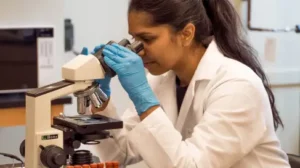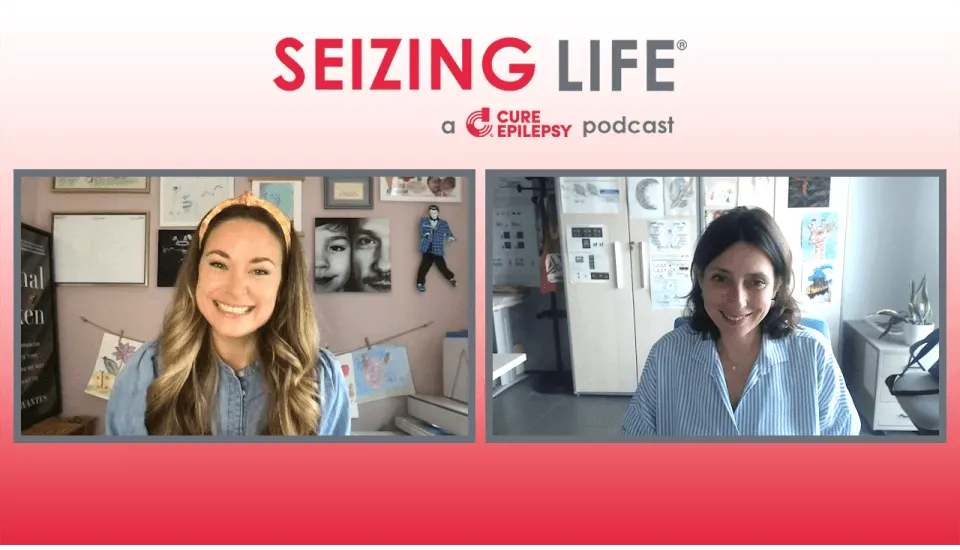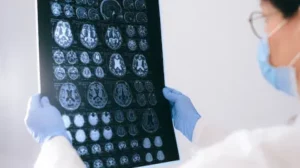Episode Overview
In July 2007, Patrick Horan was on a mission in Iraq when he suffered a catastrophic head wound resulting in a devastating traumatic brain injury (TBI). With his wife Patty at his side, Patrick struggled through months of recovery only to have much of his progress suddenly eliminated by grand mal seizures with the onset of post-traumatic epilepsy (PTE).
As Veterans Day nears, we speak with former U.S. Army Captain Patrick Horan and his wife Patty on this week’s episode of Seizing Life. The Horans describe the circumstances around Pat’s near-fatal injury, the amazing efforts of soldiers and medical personnel to save Pat’s life, the sudden, shocking onset of epilepsy months into Pat’s recovery process, and the long battle they have waged against PTE. As long-time supporters and friends of CURE Epilepsy, Patrick and Patty are dedicated to raising awareness and funding for post traumatic epilepsy research.
TBI accounts for 20% of symptomatic epilepsy in the general population and 5% of all epilepsy*. Epilepsy as a result of TBI, known as PTE, can occur as soon as right after initial brain injury to as long as years after the injury. For those struggling to recover from a TBI, the occurrence of PTE can significantly impact the recovery process, robbing patients of hard fought cognitive and physical progress gained through months of recuperation and rehabilitation. PTE is of particular concern for members the military, where the occurrence of TBI from battle wounds can often result in the development of post-traumatic epilepsy. 4.2% of all troops (Army, Air Force, Navy and Marine Corps combined) who served from 2000 to 2011 were diagnosed with a TBI.**
CURE Epilepsy has partnered with the U.S. Department of Defense to implement a research program focusing on post-traumatic epilepsy as a result of TBI. This initiative aims to improve ways to study PTE in a laboratory setting, develop biomarkers, and understand risk factors that will help us predict who will develop PTE following TBI. In this way, we will lay the groundwork for the creation of novel therapies to prevent the development of PTE.
Episode Transcript
Here is the document with timestamps removed, keeping the text on the same line as the names:
Kelly Cervantes: Hi, I’m Kelly Cervantes, and this is Seizing Life, a bi-weekly podcast produced by CURE Epilepsy.
Kelly Cervantes: Today, I’m excited to welcome long-time friends of CURE Epilepsy, Patty and Patrick Horan. As a captain in the US Army, Pat Horan was serving in Iraq in 2007 when he suffered a devastating traumatic brain injury that ultimately led to the development of post-traumatic epilepsy or PTE. The onset of epilepsy significantly impacted Patrick’s healing process, and made an already difficult road to recovery much more challenging for Pat and Patty. They’re here today to share their story and experiences, and to bring attention to the issue of TBI and PTE among our veterans. Pat, Patty, thank you so much for joining us today on Seizing Life. I’m just so thrilled to have you on and to learn more about your journey. I guess I’d love to take it from the beginning of your injury. You can tell us more about when, where, how it occurred, and your mental state at that time.
Pat Horan: I’d been in the Army for almost 10 years, and 2007, that’s when I’d been in Iraq for a year. Then one night we were going at night to do a recon, make sure the bad guys weren’t setting IEDs for the next day. It was about 2:00, 3:00 in the morning. One of my soldiers and I, we were going to go downstairs and get some water, and Gatorade, and all the stuff, and bring it back upstairs. When we were about to go downstairs, across the street, I guess, I’m not sure why, two Iraqis shot at us. My soldier kid, he jumped down, and it was too late for me. I got a shot right through my night vision that I was wearing. It exploded, and then from there it all just went into my …
Patty Horan: Helmet?
Pat Horan: … my helmet. Yeah. It went to my brain also.
Patty Horan: There’s a small flap in the helmet, so the bullet actually snuck inside the helmet.
Pat Horan: I passed out. I don’t remember any of that. It was about two months. One of my soldiers, he was trying to call me on the radio, and then he ran back upstairs. Two of my soldiers had come over to see what I was doing. My soldier, he took off my helmet and just saw that half of my brain was just gone. It was destroyed.
Patty Horan: Yeah, they couldn’t tell where the injury was. They took off the helmet, which probably wasn’t the best idea, and half his skull came off with it.
Pat Horan: Yeah. It was incredible. We went from there, it was about 10, 15 minutes away, we went to Baghdad. Then less than 10 minutes later, I was in a helicopter going to Balad. I landed there 45 minutes later, and they did the surgery right away. They took off 40% of my skull. I was there for almost eight or nine hours, I think, and then I left.
Patty Horan: Yeah. That was really lucky too, because that night he was the only one injured, and they had a clear road to get to the local field hospital. You hear about the golden hour, which he did get medical within an hour, so he was very lucky that night.
Pat Horan: Yeah.
Kelly Cervantes: It sounds like it’s a miracle that you’re talking with us today. I mean, I just, I can’t even imagine, nor do I want to. You’re in the hospital, and they perform surgery or whatever needs to happen. Did anyone, at this point, you clearly have a traumatic brain injury, did anyone mention post-traumatic epilepsy to you at this point?
Pat Horan: When I got shot to when I was in Bethesda, Maryland, it only took 36 hours. They had told one of the doctors first, second day that, yeah, you need to start taking the Keppra for my medicine.
Patty Horan: Well, yeah, I arrived at the Naval hospital in Bethesda, but you arrived there late Sunday night. I took a red eye from Seattle, Washington, and I arrived in DC on Monday morning, first thing, and was escorted to the hospital and got a medical briefing right away. This is Pat’s skull, just to show you, a model, how much is missing of the skull. One of the first things they did in the briefing was giving me a list of all the horrible things that could go wrong in the first three weeks that would end his life. He was in the ICU. His head was so swollen it looked normal, even though they had taken off probably 40% of his skull, or had been fractured because of the bullet wound. One of the things on the list of probably 30 things that could go wrong is like infection, swelling, unable to maintain pressure, the pressure on the brain.
Patty Horan: One big thing was seizures. They did say if Pat has a seizure within the first three weeks, that he would most likely pass away. That was my first introduction to epilepsy.
Kelly Cervantes: Did they say anything to you about what happens if he has a seizure after three weeks, or to be on the lookout for that?
Patty Horan: No. I mean, that really stuck in my mind, and he did not have a seizure. Prophylactically they gave him Keppra in the ICU for the first couple of weeks. Thankfully at that point, no epilepsy occurred.
Brandon: Hi, this is Brandon from CURE Epilepsy. Traumatic brain injury, or TBI, accounts for 20% of symptomatic epilepsy in the general population. CURE Epilepsy, in partnership with the Department of Defense, has implemented a research program focusing on post-traumatic epilepsy resulting from a traumatic brain injury. Go to www.cureepilepsy.org to learn what CURE epilepsy is doing to fund research in the prevention and treatment of post-traumatic epilepsy. Now back to Seizing Life.
Kelly Cervantes: How long in this journey when you come to the realization of your circumstances? I guess it would also be helpful to know how you’re doing today, and how far you’ve come from this injury, and the work that’s gone into that.
Pat Horan: It took almost maybe six weeks when I started coming out. After six weeks, then I went to RIC in Chicago, and I was wearing a helmet.
Patty Horan: A rehabilitation. Right?
Pat Horan: Yeah. I don’t know, I thought I was just getting back to normal, and they’d put me back together, and I’d go back to the Army. I really didn’t understand.
Patty Horan: Yeah, they waited six months to do a prosthetic surgery just to make sure everything’s all healed up, so six months with an exposed brain. It was really scary.
Kelly Cervantes: I can’t, it’s wild to even think about. I mean, it’s just …
Patty Horan: That we can live through something like this, actually is pretty amazing, like what the human body can heal. Yeah. We were in Chicago. He did a lot of intense rehab. They did give me this really great book on brain injury recovery. It had all sorts of things from the coma scale, how they can emerge out of a coma, and cognition levels. It was a great book. There was a section on epilepsy. No one really spoke to me much about it in Chicago. They just gave me the book. I remember seeing the page on it and thinking that it was a possibility, but I just felt like, “Oh, maybe that’s not going to happen to us,” and it did.
Kelly Cervantes: But it did, unfortunately. Can you tell us what happened when that first seizure occurred?
Pat Horan: I got lucky because I don’t know anything to me happened. Patty said she woke up around 2:00 in the morning, and just all of a sudden I was having a grand mal seizure, and Patty had no idea what a grand mal seizure was.
Patty Horan: It was probably the scariest moment in my entire life honestly. I thought he was dying. It was four and a half months into recovery, and I thought, “What in the world?” He came back a lot, alive from the gun shot wound. We’ve worked really hard and now he’s going to die tonight.
Pat Horan: She ran in the other room and looked for a nurse, and it took a couple of minutes to find a nurse. Then the nurse went with Patty to my room, and the nurse was like, “Oh, he’ll be okay. He’ll be okay. He’ll stop. He’s just having a seizure.”
Patty Horan: Yeah. She identified it as normal for the brain injury that he had, but it was a full body, very violent convulsive seizure.
Kelly Cervantes: Yeah. It’s hard to reconcile such involuntary violent body activity with normal, even given the extent of the injury. Now, when the seizure occurred, were you still taking Keppra at that time?
Pat Horan: No. We’re not sure where or when, but when I went from Bethesda to Chicago, for whatever reason I wasn’t taking any epilepsy medicine.
Patty Horan: Yeah, the medication was removed from his regimen somewhere along the way. In the early stages, I wasn’t as honed in on the epilepsy and the seizures because there were so many things going wrong, and so many things to pay attention to. I think at some point they took him off just to see how the brain did, but that was probably not the best move.
Kelly Cervantes: There’s really no way to know, and that’s the crazy thing about epilepsy and seizures is that it’s a crap shoot, this particular disease to put it slightly crassly.
Patty Horan: No, it really is. At least when it did surface, he was in bed. We were in a hospital. We could get medical quickly. It was pretty amazing that night too because it stopped and the nurse went away, and then 10 minutes later it started again. It was this rolling seizure situation, which is extremely dangerous. They called the paramedics from Northwestern, threw them on a gurney. We’re running at 2:00 in the morning through all these hallways because there’s these secret passageways from RIC to Northwestern. They had to get him on a dialectic drip as soon as possible because it could cause more brain damage. It was an exciting evening to say the least, but he did okay. All of the rehab that we’d worked on for months was just gone in like a blink.
Kelly Cervantes: Yeah, that was going to be my very next question is just how did the appearance of seizures impact Pat’s recovery?
Patty Horan: It was hard. I mean, most of his seizures were in the first couple of years, and that’s when we were working the hardest and the brain was putting itself back together. It was making the most gains, but then we’d get these like horrible grand mals, and we were doing all sorts of different medication regimens trying to figure this out. It really got in the way of recovery and very deflating many times.
Kelly Cervantes: Pat, are your seizures currently under control with medication, or are you still experiencing seizures?
Pat Horan: Right now I’ve been lucky. I haven’t had a seizure in six or seven years.
Kelly Cervantes: That is amazing. Congratulations.
Patty Horan: It is amazing.
Kelly Cervantes: What was the journey like to get to this stage of seizure freedom?
Pat Horan: Well, it was interesting. I was taking, I don’t know how they did it that first year, but they kept trying to find these different medicines, but then what they kept doing was keep taking Keppra. Then the Keppra would go higher, but they’d put something else with Keppra, and that’s what still wasn’t working for me, so every month I’d have a seizure.
Patty Horan: He had seven different medications, I think, over the course of two years.
Pat Horan: No, I had about 15.
Patty Horan: Well seizures, medications, you tried seven, or many different combinations.
Pat Horan: Finally, we’d gone to University of Michigan for aphasia, and I had a seizure there. We were in the hospital, and I was taking Keppra, and I can’t remember the other one that I was taking.
Patty Horan: I think it was Depakote.
Pat Horan: Yeah. Yeah, and one of the doctors was up there in the hospital, and she was just like, “My husband’s not leaving until he takes the Depakote again because I took it way back when I was in a RIC. I think I sat in the hospital for 10 hours or something because Patty would not let me leave until I started taking Depakote again.
Patty Horan: Yeah, Depakote seemed to be our magic bullet, but a lot of the physical medicine doctors through rehab didn’t like it because they felt it stunted the rehab, and it stunted the brain from recovering, but that was what worked. At the end of the day, we just went back to it because it was just, it seemed like also all of the seizures were stunting the rehab more than Depakote, so it became the lesser of two evils.
Kelly Cervantes: I call it the epilepsy tight rope where it is this balance between finding the right medication to control the seizures, but also still find some quality of life, still be able to make progress. It’s such a tricky thing. I think it’s such a difficult thing to get people to understand. They hear about these epilepsy medications, and they think that they are cures, and they are treatments. It sounds like from your experience, and I’d love to hear you talk more about this, but sometimes the side effects from these meds can be worse than the seizures themselves.
Pat Horan: Well, the one that I had, and I was taking it for 10 years was a Keppra. For me, I guess, it’s just an angry medicine. Every morning I’d take, how did they say it, 3000 milligrams.
Patty Horan: It’s the top dose. He was taking Keppra and Depakote.
Pat Horan: Finally, about almost two years ago because they had a really good doctor at Walter Reed, and he was like, “You need to get rid of Keppra.”
Patty Horan: Well it’s associated with rage, irritability, mood issues, which Pat was experiencing all of these. He was very angry. We couldn’t get him to participate in much anymore because of his level of irritability. He just stopped participating in life. He was angry to everyone. We finally decided, even just two years ago, to do this huge med change, which was scary. He has to be hospitalized and on a monitoring unit for five days. He was tethered to an EEG. It felt like we’re sick again, we’re not well. Then he did two weeks on the brain injury board there too to make sure wasn’t something else going on other than the Keppra, but it ended up being the medication. We got rid of it without any issues, which was really huge. That was a win, but it’s a lot to change meds too.
Kelly Cervantes: Yeah. Yeah. These are serious drugs.
Patty Horan: Yeah, you have to be hospitalized and give up time in your life. It’s not just that week. It’s a three-month window that possibly you’re going to have a seizure. He can’t be alone. We have to be very safe in the things that we do. He can’t go swimming. He can’t do a lot of activities, so yeah.
Kelly Cervantes: I’d love for you to tell me about the Stroke Comeback Center and the podcast called the Slow Road to Better.
Pat Horan: Well, I’ve been going to the Stroke Comeback Center. It’s more than eight years I’ve been going there. They’ve really been just getting better, reading, and writing, and talking. They started three years ago. They decided, “Hey, well, let’s just have a podcast.” We’re not big time doctors, or speech, everything. The one lady is from speech, and she was like, “All right, guys. Let’s get on there and just start saying whatever you want to talk about and different stories.” It was pretty fun. It’s been pretty good.
Kelly Cervantes: Where is this center located, and what are its goals?
Pat Horan: It’s called Vienna, Virginia. It’s like 20 minutes to DC.
Patty Horan: It’s a nice group of people that had stroke or brain injury. There’s definitely people that suffer from epilepsy there. It’s just a place where they can come together and talk about how life is different after injury or disease. Pat really enjoys it. It runs the gamut. They have people as young as in their twenties that have had motorcycle accidents, or Army, or military, or people that are older and had strokes.
Kelly Cervantes: What is life like for both of you now?
Patty Horan: Well, I guess now, we were just talking about it, it’s interesting. We just lost our doctor, and we have his new team now over at Walter Reed. They have such a different way of treating epilepsy. Because of COVID, we’re not making changes with that. Our goal is monotherapy eventually. He’s on BRIVIACT instead of Keppra. That’s coming up, I hope, in the next year, but we’re going to wait until hopefully there’s a vaccine or something because we don’t want to put Pat in jeopardy. There’s not whole lot to do. COVID, it’s taken away a lot of the recreational activities. He’s doing Stroke Comeback still virtually. There’s a program through Wounded Warrior Project that’s giving him a mentor, so they might do some things virtually, but everything, we’re home. Yeah.
Kelly Cervantes: Patty, I know that you personally have made such an impact with CURE Epilepsy’s DOD panel. I’d love to hear about your experience with the panel and helping us with the grant.
Patty Horan: Sure. Being on that panel is it’s really exciting and it’s a great honor for me to be participating. Post-traumatic epilepsy, there is no cure right now. I think it’s a great place to spend research dollars because there’s an understanding of why the service members have the epilepsy. There is a place in that from onset of injury, to epileptogenesis, to the process where it could possibly be stopped. That’s where we focus a lot of the science on the panel from injury point to actual first onset of seizure. For Pat, it was four months, and for a lot of service members, there is this window of recovery and then the seizure happens. That’s our focus. It’s exciting all the science and research that’s coming up. There’s a lot of collaboration between scientists and among labs because CURE and DOD requires it. I feel like that the science is being pushed forward a lot faster than in some of the other programs. We’re going to reconvene again early in the new year, and I’m really excited about what we’re going to learn and the new research that comes forward.
Kelly Cervantes: I think that is such a fascinating point that you make that the idea of preventing epilepsy from ever occurring. I think so much we focus on curing it after it’s already happened. If you have these service members where you know that they are high risk in developing this because they’ve had the TBI, if you know that window, and there are preventative measures that we can take so that the epilepsy never occurs, that way they never have these setbacks in therapy, and they can lead these more full lives, it’s really encouraging to think that we could really make a huge, huge impact in these service members’ lives, and anyone who suffers a TBI from a car accident, or some other a fall. You are pushing science forward, and I know the CURE Epilepsy family is just so grateful for your contributions. Thank you both so, so much for sharing your journey and your story. I am just, again, so grateful for your service to our country, but also to this community. I just, I can’t thank you enough.
Patty Horan: Thank you for having us on today.
Pat Horan: Yeah.
Patty Horan: Yeah, we appreciate it.
Kelly Cervantes: Thank you, Pat and Patty, for sharing your story and providing a personal perspective on the impacts of TBI and PTE. While research has established a correlation between TBI and PTE, we still don’t fully understand the mechanisms that lead to the development of epilepsy. That’s why CURE Epilepsy has partnered with the Department of Defense to implement a research program focusing on PTE as a result of TBI. By establishing a multicenter multi-investigator research team to study PTE in a laboratory setting, we will lay the groundwork for the creation of new therapies to prevent the development of PTE. If you’d like to support, CURE Epilepsy in its efforts to prevent post-traumatic epilepsy, please visit www.cureepilepsy.org/donate. Your support and generosity are greatly appreciated. Thank you.
Speaker 5: The opinions expressed in this podcast do not necessarily reflect the views of CURE. The information contained herein is provided for general information only and does not offer medical advice or recommendations. Individuals should not rely on this information as a substitute for consultations with qualified healthcare professionals who are familiar with individual medical conditions and needs. CURE strongly recommends that care and treatment decisions related to epilepsy and any other medical condition be made in consultation with a patient’s physician or other qualified healthcare professionals who are familiar with the individual specific health situation.





